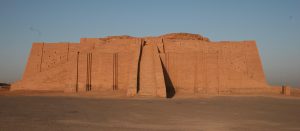Akiti is the Sumerian form of the word akitu, the name of the Babylonian festival celebrating the new year. It refers both to the holiday and the special building where it was held.[1] Unlike the festival for the chief god Marduk in Babylon, which was held only in the spring, the akiti celebrated for the moon-god Nanna at Ur was also held in the seventh month, around the time of the autumn equinox. The celebration involved the image representing the god traveling by boat from the city to the akiti-house and then returning to the city with great fanfare.[2]

The autumn festival was the more important of the two. Why? Nanna was the patron god of Ur, and the fall akiti, which lasted at least eleven days into the month,[3] took place as the waxing moon grew larger and larger, symbolizing the god’s reentry into his city just as the days were getting visibly shorter and the moon asserted his dominance in the sky over Utu, the sun-god.[4]
Similar festivals were held in many cities for their patron gods, from Ur to Babylon to Harran in northern Mesopotamia. The question is why the ritual required the patron god to travel from his or her city to the akiti-house and back. Scholars who have studied this festival report that “nothing unusually significant occurred” at the akiti-house.[5] So, why bother?
The solution is the obvious. Perhaps the best-known children’s riddle is, “Why did the chicken cross the road?” The answer to this riddle is the obvious: “to get to the other side.” Why then was the akitu-house built outside the city? The answer: “so that the gods could march back into the city.”[6]
But why? We may never know for sure, but there’s a fascinating tidbit buried just beneath the surface of the historical record. It appears the akiti rites at Ur included a ritual procession around the fields outside the walls, presumably to call for divine protection of the crops. This circular march, or circumambulation, was combined with offerings to Nanna, a ritual purification of the gate to the moon-god’s temple, and of course tithing by merchants to the temple.[7]
The significance of the circumambulation ritual will become obvious later in this series. And it may be much, much older than the city of Ur.
In September of 1869, British military engineer and explorer Sir Charles Warren climbed to the summit of Mount Hermon on behalf of the Palestine Exploration Fund (PEF). The PEF was founded in 1865 under the patronage of Queen Victoria. The society included some of the giants in the field of archaeology, such as Sir William Flinders Petrie, T. E. Lawrence (“of Arabia”), Kathleen Kenyon, and Sir Leonard Woolley,[8] who excavated Ur in the 1920s. But it’s no coincidence that many of those sent into the field had military training; by the second half of the nineteenth century, the Ottoman Empire was crumbling, and the great powers of Europe had their knives out, ready to carve up the carcass. While we’ve learned a lot about the ancient world from the work of men like Warren, Petrie, and Lawrence, the British government collected useful intelligence at the same time.
Anyway, on top of Hermon, more than nine thousand feet above sea level, Warren visited an ancient temple called Qasr Antar, the highest manmade place of worship on the planet. It was probably built during the Greek or Roman periods, so it only dates to about the second or third century BC at the earliest.
But inside the temple, Warren found an artifact that had been overlooked by visitors for nearly two thousand years—a stela, a slab of limestone about four feet high, eighteen inches wide, and twelve inches thick, inscribed in archaic Greek:
According to the command of the greatest a(nd) Holy God, those who take an oath (proceed) from here.[9]
Because the inscription is Greek rather than a Semitic language like Aramaic, Hebrew, Canaanite, or Akkadian, the stela probably can’t be dated earlier than Alexander the Great’s invasion of the Levant in the late fourth century BC. But it still connects Mount Hermon to the Watchers of Genesis 6, whose mutual pact on the summit is described in the Book of 1 Enoch:
Shemihazah, their chief, said to them, “I fear that you will not want to do this deed, and I alone shall be guilty of a great sin.” And they all answered him and said, “Let us all swear an oath, and let us all bind one another with a curse, that none of us turn back from this counsel until we fulfill it and do this deed.” Then they all swore together and bound one another with a curse. And they were, all of them, two hundred, who descended in the days of Jared onto the peak of Mount Hermon.[10]
Since the “greatest and holy god” on Warren’s stela is linked to the Watchers, it almost certainly refers to the Canaanite creator-god, El, who was believed to make his home on Mount Hermon, which was essentially “the Canaanite Olympus.”[11] The summit of Hermon has been scooped out like a giant bowl, probably to receive a drink offering, something scholars call “the rite of hydrophory.”[12] This ritual was called yarid in Hebrew, based on a root that means “to come down,” which it shares with the names Jared and Jordan (since the river “comes down” into the Galilee from Hermon). This suggests that the Watchers did not descend to Mount Hermon in the “days of Jared,” but rather in the days when yarid was performed on the summit of Hermon.
The point is this: Warren noted that those bringing the yarid had to approach the summit in a specific way:
On the southern peak there is a hole scooped out of the apex, the foot is surrounded by an oval of hewn stones, and at its southern end is a Sacellum, or temple, nearly destroyed: the latter appears to be of more recent date than the stone oval…
The oval is formed of well-dressed stones, from two to eight feet in length, two and a-half feet in breadth, and two feet thick; they are laid in a curved line on the uneven ground, their breadth being their height, and their ends touching each other.[13]
In other words, to reach the summit of Mount Hermon in ancient times, one had to circumambulate the peak, walking in a spiral with the summit always on the left—counterclockwise.
That leads to this question: Is there a link between religious rituals on Mount Hermon and the oldest akiti rites for the moon-god at Ur?
Admittedly, this is speculation, another bit of circumstantial evidence as we build our case. There is smoke, but not exactly a smoking gun.
One more note, a hint at the importance of the moon-god in the ancient Near East: During the time of the patriarchs, which scholars call the Old Babylonian period, the moon-god Nanna/Sîn was, at least for some, the most important god in the pantheon.
Even though Enlil was still king of the gods at that point in history, a text fragment from Nippur written during the Old Babylonian period, only translated in 2011, explicitly describes the moon-god as ruling over the Mesopotamian divine assembly, which was called the Ubšu-ukkina. Anu and Enlil, whom we’d expect to be the presiding deities, are described as advisors, along with the other “gods who decree.”[14]
You, who stand before him to sit in the Ubšu-ukkina
An, Enlil, Enki, Ninhursag, Utu, and Inanna sat in assembly for the king
They advised him there.
Nanna sets the holy…in order.…”
The great gods were paying attention to….
Suen [Sîn], his assembly’s decision, his speech of goodness, abundance.…
for Suen, they implement abundance in heaven and earth properly(?)
The king suitable for holy heaven, the barge in the midst of heaven.[15]
“The barge in the midst of heaven” is the crescent moon. Besides resembling the horns of a bull, it also looks like a reed boat sailing across the night sky. Even though bits of the tablet are missing, it’s clear that Sîn was “the king” in the Mesopotamian divine assembly, with the other “great gods” in subordinate roles. Marduk isn’t even mentioned. This supports the theory that the Amorite founders of Babylon, even though they hailed from the city of Marduk, considered the moon-god, Sîn, their patron.
It’s also important to remember that to Mesopotamians, the Ubšu-ukkina was a physical place. The assembly of the gods took place in Nippur, inside Enlil’s temple complex the E-kur, or “House of the Mountain.”
That’s important, too. From Eden to Armageddon, this long spiritual war is all about the mountain where the gods assemble. The prize is Yahweh’s har môʿēd (“mount of assembly”)—Zion.
Next week: City of the moon-god.
[1] J. A. Black, “The New Year Ceremonies in Ancient Babylon: ‘Taking Bel by the Hand’ and a Cultic Picnic,” Religion, 11:1 (1981), 40.
[2] Hall, op. cit., 336.
[3] Ibid., 336.
[4] Cohen, op. cit., 402.
[5] Ibid., 403.
[6] Ibid., 404.
[7] Beate Pongratz-Leisten, “Akitu.” The Encyclopedia of Ancient History, First Edition, edited by Roger S. Bagnall, et al. (Hoboken, NJ: John Wiley and Sons, 2013), 265–266.
[8] “The History of the PEF.” (https://www.pef.org.uk/history/), retrieved 10/14/18.
[9] George W. E. Nickelsburg, 1 Enoch 1: A Commentary on the Book of 1 Enoch, Chapters 1–36 (Minneapolis: Fortress, 2001), 81–108.
[10] George W.E. Nickelsburg, 1 Enoch: The Hermeneia Translation (Kindle edition) (Minneapolis: Fortress Press, 2012), 23–24.
[11] Edward Lipiński, “El’s Abode: Mythological Traditions Related to Mount Hermon and to the Mountains of Armenia,” Orientalia Lovaniensa Periodica II, (Leuvan, 1971), 35.
[12] Ibid., 29.
[13] Charles Warren, R. E., “The Summit of Hermon, With an Illustration.” Palestine Exploration Fund Quarterly Statement 2.5 (Jan. 1 to March 31, 1870), 212.
[14] Jeremiah Peterson, “Nanna/Suen Convenes in the Divine Assembly as King,” Aula Orientalis 29 (2011), 279.


